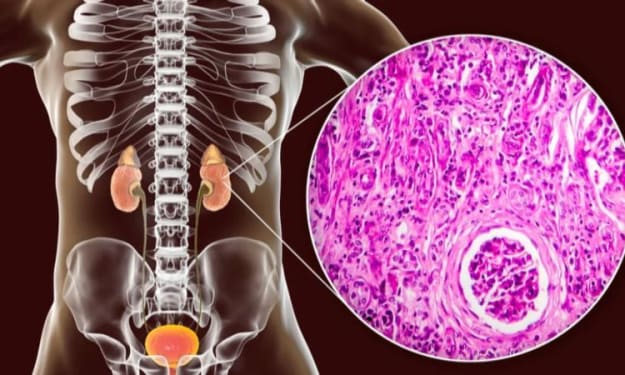Content warning
This story may contain sensitive material or discuss topics that some readers may find distressing. Reader discretion is advised. The views and opinions expressed in this story are those of the author and do not necessarily reflect the official policy or position of Vocal.
CYSTINURIA GENETIC BASIS, SYMPTOMS, AND TREATMENT OPTIONS
ALL WHAT YOU NEED TO KNOW

Cystinuria is a rare genetic disorder characterised by the excessive excretion of cystine, an amino acid, in the urine. This can lead to the formation of cystine kidney stones, which can cause severe pain and complications. Cystinuria is usually inherited and requires lifelong management, including dietary changes and medications, to prevent stone formation.
Cystinuria poses unique challenges in the realm of renal health. This condition stems from mutations in the SLC3A1 and SLC7A9 genes, disrupting the kidney’s ability to reabsorb cystine, an amino acid. Consequently, cystine accumulates in the urine, eventually forming crystals that pave the way for the development of kidney stones.
Molecular Structure of cystineMolecular Structure of cystine
These mineral concretions can lead to excruciating pain and, if left unmanaged, may result in severe complications. Understanding the causes, symptoms, and contemporary treatment modalities for cystinuria is paramount for patients and healthcare providers.
This article will delve into the details of cystinuria, shedding light on its aetiology, the array of symptoms, and the cutting-edge treatments that stand as beacons of hope for those grappling with this condition.
Microscopic image of Cystine crystalMicroscopic image of Cystine crystal
Understanding the Genetic Basis of Cystinuria
Cystinuria is a genetic disorder with a well-understood genetic basis. It is caused by mutations in specific genes that regulate the transport of amino acids, including cystine, in the kidneys. The primary genes associated with cystinuria are SLC3A1 and SLC7A9, which code for proteins involved in amino acid reabsorption.
These mutations disrupt the normal reabsorption of cystine in the renal tubules, leading to its excessive excretion in the urine. When cystine concentrations in the urine exceed their solubility, they can crystallise and form kidney stones.
Cystinuria is typically inherited in an autosomal recessive pattern, meaning an affected individual inherits mutated copies of the gene from both parents. Individuals with one mutated gene (carriers) usually do not exhibit symptoms but can pass the mutation to their offspring. When both parents are carriers, there is a 25% chance of having a child with cystinuria.
Autosomal Recessive MutationAutosomal Recessive Mutation
Understanding the genetic basis of cystinuria is crucial for genetic counselling and early diagnosis, and developing treatment strategies to manage the condition effectively.
Symptoms of Cystinuria
Here are the symptoms of cystinuria:
Pain: This is often the most prominent symptom. The pain is typically felt in the lower back or sides and can be severe, resembling the pain of a kidney stone.
Hematuria: Blood in the urine is a common sign of kidney stones, including those caused by cystinuria.
Frequent Urination: Individuals with cystinuria may feel the need to urinate more frequently.
Nausea and vomiting: These symptoms may occur due to the pain and the body’s response to the kidney stones.
Urinary Tract Infections (UTIs): Recurrent UTIs can be associated with cystinuria, especially if there are blockages in the urinary tract.
Stones in the Bladder: In severe cases, cystine stones can form in the bladder, causing additional complications.
Recurrent Stone Formation: Individuals with cystinuria are more likely to develop recurrent kidney stones.
Treatment Options For Cystinuria
Treatment options include
Hydration: Maintaining a high fluid intake is crucial to preventing cystine stone formation. Diluted urine helps reduce the concentration of cystine and inhibits crystal formation.
Dietary Changes: Restricting the intake of cystine-rich foods, such as red meat, poultry, and dairy products, can help reduce cystine levels in the urine.
Medications:
Cystine-Binding Agents: Drugs such as D-penicillamine and tiopronin help bind with cystine, reducing its concentration in the urine.
Alkalinising Agents: These medications raise the pH of the urine, which can help prevent cystine crystal formation.
Extracorporeal Shock Wave Lithotripsy (ESWL): This non-invasive procedure uses shock waves to break down kidney stones, making them easier to pass.
Percutaneous Nephrolithotomy (PCNL): In cases where stones are large or numerous, a surgical procedure may be necessary to remove them.
Endoscopic Surgery: This technique involves using a thin, flexible tube with a camera to locate and remove stones directly.
Alkalinisation: Medications such as potassium citrate may be prescribed to increase urine pH, which makes cysteine less likely to crystallise.
Thiol Drugs: Medications such as D-penicillamine and tiopronin can bind to cystine in the urine and reduce its concentration.
Kidney Transplantation: A transplant may be considered in severe cases where kidney function is severely compromised.
About the Creator
Enjoyed the story? Support the Creator.
Subscribe for free to receive all their stories in your feed. You could also pledge your support or give them a one-off tip, letting them know you appreciate their work.





Comments
There are no comments for this story
Be the first to respond and start the conversation.